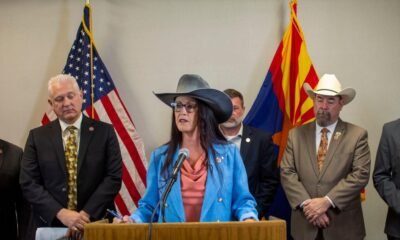2024 election
GOP’s Bid to Restrict Emergency Powers: Unveiling Real-Life Impacts

The purpose of declaring an emergency at the state level is to equip the government with the authority and resources to address crises swiftly and effectively.
This emergency declaration empowers the governor and state agencies to implement measures that are not usually allowed. These measures are designed to cut through red tape and provide temporary relief from ordinary regulations.
Key purposes include:
Mobilizing Resources: Enables the rapid allocation of state resources—such as funding, personnel, and equipment—to affected areas.
Regulatory Flexibility: Allows temporary suspension or modification of regulations that may hinder prompt response efforts. This can include waivers for healthcare facility requirements, licensing reciprocity for out-of-state medical professionals, and expedited procurement processes.
Information Gathering: Enhances the ability to collect and issue critical information, including surveillance data, to monitor and manage the situation effectively.
Public Safety Measures: Authorizes the implementation of necessary public safety measures, such as evacuations, curfews, and quarantine orders, to protect the public.
Coordination and Support: Facilitates coordination among state agencies, local governments, federal entities, and non-governmental organizations to ensure a unified, efficient response.
An emergency declaration is crucial for state leaders to mitigate the impact of crises, protect public health, and restore normalcy as quickly as possible.
Proposition 135 on November’s ballot proposes an amendment to the Arizona Constitution that would significantly limit the governor’s ability to respond to emergencies.
If passed, these restrictions would be difficult to reverse, requiring another amendment and voter approval. This proposition poses several risks to public health and safety:
Restricting the governor’s response capabilities to public health crises, such as pandemics or radiologic events, could severely hinder rapid deployment of medical resources, quarantine enforcement, and coordination with federal agencies.
Loss of regulatory flexibility after 30 days could result in several complications:
Health care professionals from other states could not provide services in Arizona beyond 30 days, potentially leading to severe health care staffing shortages during prolonged emergencies.
Emergency responders would lose critical legal protections, discouraging volunteerism and participation in emergency operations.
Hospitals and clinics would be unable to adapt swiftly to a surge in patient numbers, affecting their ability to provide prompt and adequate care.
Setting up temporary clinics for mass distribution of antivirals or vaccines would be obstructed, delaying public access to life-saving treatments.
The removal of legal protections for responders would increase the risk of litigation, potentially reducing the number of willing participants in emergency responses.
Essential data collection for monitoring and controlling the spread of diseases would be hampered, impeding informed public health decisions.
Prop. 135 would constrain the state and local governments’ abilities to safeguard public health during emergencies by imposing stringent limitations on necessary regulatory flexibility and emergency response measures. This rigidity could lead to delayed responses, inadequate medical care, and increased mortality during crises.
Furthermore, the amendment introduces unnecessary inflexibility. The current system already includes checks and balances to prevent abuse of emergency powers, such as A.R.S. § 36-787, which limits public health emergency declarations to 120 days and requires legislative approval for any extensions beyond this period, ensuring balanced power and oversight.
The Arizona Public Health Association urges voters to think carefully about the practical implications of this constitutional amendment before deciding how to vote on Prop 135.


















